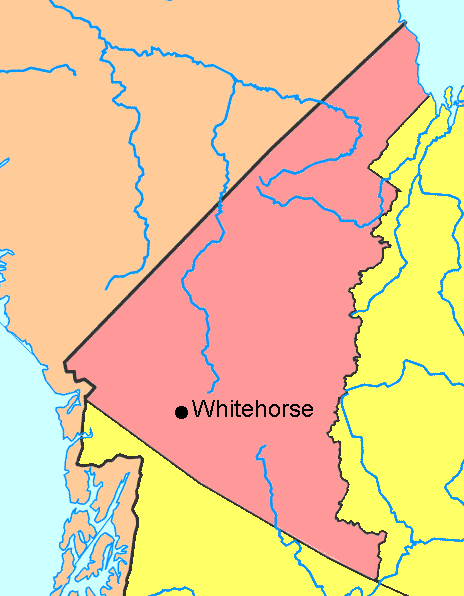|
Yukon Territory
Yukon or Yukon Territory or (usually) The Yukon is one of Canada's northern territories, in the country's extreme northwest. It has a population of about 31,000, and its capital is Whitehorse, with a population of 19,000. People from Yukon are known as Yukoners. The very sparsely populated territory abounds with natural scenic beauty, with snowmelt lakes and perennial whitecapped mountains. Although the climate is arctic and subarctic and very dry, with long cold winters, the long sunshine hours in short summer allow hardy crops and vegetables, along with a profusion of flowers and fruit to blossom. The territory is the approximate shape of a right triangle, bordering the American state of Alaska to the west, the Northwest Territories to the east and British Columbia to the south. Its northern coast is on the Beaufort Sea. Its ragged eastern boundary mostly follows the watershed between the Yukon Basin and the Mackenzie River watershed to the east in the Mackenzie mountains. Canada's highest point, Mount Logan (5959 m), is found in the territory's southwest. Mount Logan and a large part of the Yukon's southwest are in Kluane National Park and Reserve, a UNESCO World Heritage Site. Other National Parks include Ivvavik National Park and Vuntut National Park in the north. Most of the territory is in the watershed of its namesake, the Yukon River. The southern Yukon is dotted with a large number of large, long and narrow glacier-fed alpine lakes, most of which flow into the Yukon River system. The larger lakes include: Teslin Lake, Atlin Lake, Tagish Lake, Marsh Lake, Lake Laberge, Kusawa Lake, Kluane Lake. Lake Bennett, B.C., on the Klondike Gold Rush trail is a smaller lake flowing into Tagish Lake. Other watersheds include the Mackenzie River, the Alsek-Tatshenshini as well as a number of rivers flowing directly into the Beaufort Sea. The two main Yukon rivers flowing into the Mackenzie in the Northwest Territories are the Liard River in the southeast and the Peel River and its tributaries in the northeast. The capital, Whitehorse, is also the largest city with more than two thirds of the population; the second largest is Dawson City, (pop. 1800) which was the capital until 1952. Other communities include Beaver Creek (88), Burwash Landing (68), Carcross (201), Carmacks (431), Destruction Bay (43), Faro (313), Haines Junction (531), Mayo (366), Old Crow (299), Pelly Crossing (328), Ross River (337), Tagish (206), Teslin (267), and Watson Lake (1,071). |
||||||||||
